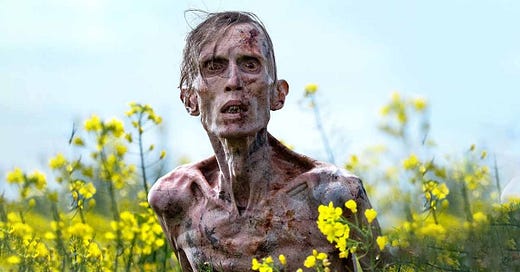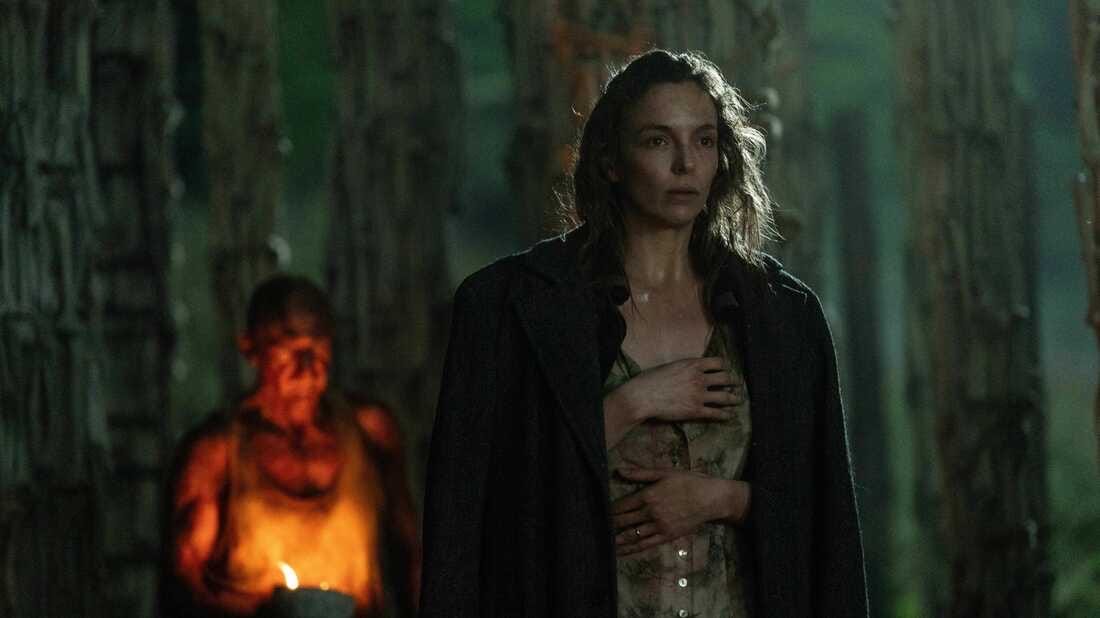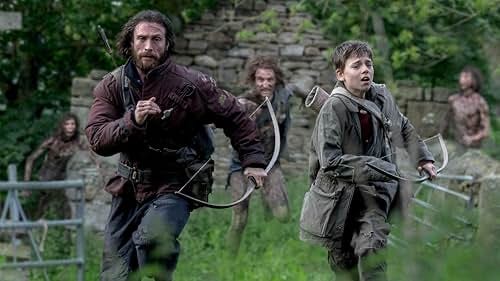‘28 Years Later’: A Worthy, Wacky Successor
Danny Boyle's long awaited threequel is here, but will it live up to expectations?
(Spoilers Ahead)
After almost the exact amount of years in the title, Danny Boyle has returned to direct the highly anticipated ‘threequel’ to his iconic 2002 film 28 Days Later.
Following a trailer that took the internet by storm and rumours of a zombified Cillian Murphy returning, my hopes for this film skyrocketed, and it quickly became one of my most highly anticipated of the year. When reviews began pouring in, they were some of the most divisive of any film I’ve seen this year. So, I went into this film with low expectations, hoping to be pleasantly surprised - and I was.
With the first instalment of this franchise, 28 Days Later, being one of my favourite films of all time, and its follow-up, 28 Weeks Later being one of the most boring films I’ve ever sat through, I’m glad to say that this film was a perfect return to form of everything that made the first film so great. The directing has ‘Boyle’ written all over it, something the second film was sorely lacking in, a return to the fast-pace and gritty, grimy style of the original that made its iconography so memorable.
The editing is also very remnant of the original instalment with its jarring cuts, with some additions that felt very video-game esque to me. The multiple angles of each kill felt very stylistic, and I got a real kick out of it in the beginning, but as it went on, this choice began to feel a little repetitive after the novelty wore off.
The cinematography is also notably gorgeous, the greenery of the mainland fields contrasting greatly to the washed out, darker tone of the abandoned London from the first film. This has some of the most beautiful shots and set pieces of the year - as someone who is half Geordie, I felt unbridled joy seeing the Angel of the North on the big screen, so I can only imagine how viewers in the North felt. (All I need now is to see how Wales is faring in this universe - Danny Boyle, show me the Welsh countryside/Cardiff Castle in one of these films and my life is yours. This film did feature the characters singing Tom Jones’ Delilah in a bar, which is practically a second national anthem here in Wales, so there’s still hope!)
The score by Young Fathers also helps set the tone for the film as a whole, providing a perfect blend of eeriness and nostalgia for a world that no longer exists. However, I truly believe this film would be nothing without its cast. There is truly not a weak link among them - every cast member gets a chance to shine and they are all fantastic.
Aaron Taylor-Johnson is standout in the first act, bringing to the character of Jamie a nuanced balance of paternal love masked by toxic masculinity even in a ruined world, and a more sinister, underlying malevolence that I’m sure will come out in the second film.
Ralph Fiennes is fantastic, even with such limited screen time he is able to bring such soul to his character, Dr Kelson. From the looks of him in the trailer, I and many others expected him to play a villainous role, when in reality he was a beacon of hope in the film who showed kindness to two people who needed it the most, a representation of humanity’s ability to come together in the face of division (or in this case, a rage virus).
Jodie Comer is terrific as Isla, a truly tragic character who brings heart to the film when it focuses on her mother-son relationship with Spike, played by Alfie Williams, who there is truly something to be said about. For such a young actor, his talent truly holds this film up. His chemistry with Comer in particular provides an equal amount of levity and tragedy to the second and third acts that make the film feel deeply and unapologetically human. Williams’ career will undoubtedly excel after his breakout role in this film and I truly believe he deserves every bit of praise and success coming his way.
To run through the narrative of the film, the opening is in keeping with the other two movies, in that it’s absolutely brilliant. It immediately thrusts you into the world of this film, the brutality and the violence that the survivors had to endure. The opening involving children - in particular one child who will be important at the end - makes it particularly harrowing. Killing children has always been taboo in horror movies but here it truly shows that in a country plagued by the rage virus, no one is safe - anyone can and will die at any time, immediately raising the stakes for this film and the next.
The shot of the blood of one of the children spattering onto an old 2000s TV playing an episode of Teletubbies really stood out to me, highlighting the metaphorical loss of innocence and how everything children in this world once found comfort in is now tainted with death and destruction - a theme that comes back in the end and will no doubt play an important part in the next film.
This film, taking place such a huge amount of time after Days and Weeks, also allows its narrative to explore how the infection has evolved over almost three decades. The depiction of the infected evolving contrasting the regression of humanity that we see in this film is truly striking. The island setting feels very medieval, showing the audience how humankind has had to move backwards to cope with the infection plaguing the UK. Meanwhile, the infection has grown and mutated in ways the survivors don’t understand, as though the infected are meant to live on and thrive, not humans.
This theme is highlighted with the interesting editing choices in the first act, where we cut between Spike and Jamie’s adventure on the mainland to footage not even from the film, but from what seems to be old war videos and medieval battle recreations - a parallel of how humanity lives now and how the virus has forced them back to their most primal roots, as it also has with the Infected.
On the topic of the Infection, it’s made all the more terrifying here with the film’s depiction of its evolution. The Alpha is absolutely horrifying, every scene with him is a highlight, particularly the chase scene through the water at the end of the first act, which is shot and lit beautifully, a great juxtaposition to the horror of the situation.
The running infected that we saw in the first two instalments are as chilling as ever, their unnatural movements and speed igniting a fight or flight response even amongst the audience, as though they’re something we were never meant to see. Even the slow-moving infected are bone-chilling. In a world where such sluggish, seemingly easy to defeat creatures are still a threat, the fear is heightened in the audience and the characters as we wonder if the constant fear and paranoia of this world is even worth surviving.
A scene that stuck out to me around the midpoint of the film was the Infected birthing scene. Aside from an Infected woman giving birth to a healthy baby - who will definitely act as a cure in one of the next two instalments, mark my words - the solidarity of women was something that struck me in this scene. Despite the woman being taken over by a disease that takes away all of her humanity, Isla is still able to connect with and calm her. The shot of the two women joining hands as Isla helps the woman give birth elicited a particular emotion in me. In my mind, this was a commentary on the importance of women and sisterhood even in a world where solidarity seems hard to find. With Danny Boyle recently saying in an interview for this film how important women are to the horror community, it would not be out of place for this message to come from him, focusing on the importance of females in and out of the story, and how women will always support each other in any circumstance (yes, I will find a way to talk about sisterhood in any article).
One thing I was not expecting was how emotional this film would be. Isla being diagnosed with cancer reminds the audience that even in a world where rage-filled Infected run rampant, such health issues are still prevalent and, with the downfall of modern medicine, just as tragic as they are in our world.
The main death of the film being from such a ‘normal’ disease puts the emphasis on just how human this story is. At its core, it tells the story of a young boy struggling with who he is in this world, fighting through such tragedies as his father not loving him enough and his mother being terminally ill. This is a story that could be your average coming of age tale, but instead, it takes place in a world with zombies. As much as this works for me, as a big lover of humans continuing to just be humans in the most derelict of settings (The Walking Dead, The Last Of Us, etc), I think this might be why the film didn’t land with a lot of general audiences.
A common complaint I’ve seen is that the film wasn’t ‘zombieish’ enough, as, from an outside perspective, you would expect this to be a zombie film where all of the main story beats focus on the Infection. But this film follows on from 28 Days Later, which is a story set in a zombie-infested country that actually focuses on the best and worst of humanity - the beauty of coming together and finding family in a ruined world, and the horror of what some humans become in a world with no consequences. 28 Years Later is similar as it focuses on the beautiful, vulnerable parts about being human and how despite everything, these characters still care and love even in a dead world. However, it’s been teased that 28 Years Later: The Bone Temple will be a much darker story, one that will perhaps parallel the story of the worst of humanity that we saw in the third act of 28 Days Later, this time focusing on the Jimmies rather than the army.
And now, with the mention of the Jimmies, we come to the very controversial ending of the film. Unlike the majority of the internet, I don’t hate this ending at all, however I do agree that it was very jarring in tone from the rest of the third act.
Personally, I would have cut the film after the absolutely beautiful scene where Spike climbs to the top of the bone temple and places his mother’s skull on the top, facing the sun, intercut with Spike leaving the baby with his father and his voiceover of the letter he left. It would have been a heart-touching, bittersweet note to leave the main body of the film on, and allow the audience to process and breathe after what they’ve witnessed. However, as the last few minutes of the film with Jack O’Connell’s Jimmy are very important, I would have preferred it to be post-credits, or even mid-credits if the filmmakers thought the audience would walk out and miss this scene that sets up the next film.
The character of Jimmy has come under a lot of scrutiny on the internet after this scene. For one, a lot of people haven’t seemed to grasp the tone of this scene and what it all means, and for two, he looks uncannily similar to Jimmy Saville - which is 100% intentional and will 100% be important in the next film. Jack O’Connell gives a magnetic and intriguing performance in his few minutes of screen time, despite the awful wig they put him in, and I’m very excited to see where they take this character in the next film.
The character of Jimmy Crystal is the same kid we follow in the first ten minutes of the film, who was watching Teletubbies when the outbreak took hold of his family and friends. We see him and his new friends wearing the colour scheme of the Teletubbies, cartwheeling and jumping around like Power Rangers, and dressed like a man who was once considered an icon and the face of a lot of children’s childhoods, for better or worse, Jimmy Saville. However, as some people seem to think, this is far from glamorising Saville in any way. These characters and who Jimmy models himself after represents a group of people clinging onto what they remember from their childhoods before everything they know was torn apart. With the outbreak taking place canonically in 2002, Saville would not have been exposed yet, meaning in the eyes of Jimmy and his friends, Saville would still be seen as a charitable, nostalgic figure, thus heightening the sheer Britishness of this film and its critiques of British society.
For now, we can only theorise what the appearance and the parkour these characters are shown to be capable of means - my theory is that these characters will act as a commentary on false idols. At the beginning of the film, before he is taken out to the mainland to ‘become a man’ by his father, Spike looks at an action figure of a Power Ranger, who the cult’s outfits and stylised fighting style are based on at the end. Perhaps foreshadowing how Spike will fall into their trap and trust them because they replicate characters a young boy like Spike would view as ‘cool’. Paired with the Saville likeness, I can definitely see the second film tackling the idolisation of awful people and how the people in league with them will do anything to cover up and defend their misdeeds.
To conclude, 28 Years Later exceeded my expectations and then some. 28 Days Later is one of my favourite films of all time and in my opinion, 28 Years Later is very close to being perfect, which is refreshing to see after the disaster what was 28 Weeks Later.
I can’t wait to see where this story and these characters will go in The Bone Temple, and hopefully a third film.
My biggest gripe with this film is that it didn’t include the iconic theme of these films, In a House, In a Heartbeat. But there’s still hope for it to be included in the next one!
Final Rating: 4.5/5.
28 Years Later is in UK cinemas now.








Fantastic article Em! I loved your analysis of the ending scene, I feel I now appreciate it more than I did initially. It's jarring but with your explanation of what it all means, it makes more sense in the context of the movie and trilogy!
I love your reading of the birth scene as a real touchpoint for human empathy in the film Em. I think it has one of the most bizarre displays of sentimentality in the film as its accompanied by the pregnant infected wailing the entire time but it's definitely one of its most striking displays of female companionship too as there's a clear sense of mutual assistance between Isla and the infected she's assisting in the birth. Fantastic review once again, looking forward to reading more!